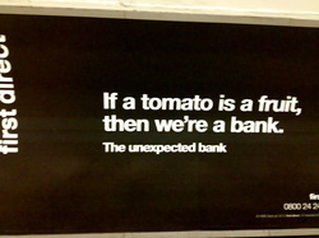Final Capstone: The British and Food Advertising An example of the creative ads, involving food references.
Finishing a semester long research study comes with so many things to look back on!
As a recap, my United States findings showed how lax the legal restrictions are when dealing with advertising. I heard from advertising professionals, Phil Johnston and Fran Collins, about puffery: how many advertisements get around these restrictions. I also heard from a Craig Decker, a restaurant owner, and how he uses advertising to cut through the fast food market. While being in London, I found many differences. First and foremost the legal system is EXTREMELYproactive when it comes to advertising. While visiting the Department For Business, Innovation and Skills, I spoke with Tim Lloyd, who elaborated on this process. Instead of taking years to take down an advertisement (like the U.S.), he said in the United Kingdom, the government is with the advertiser during every step of the way. Many companies even have its own legal team to make sure the ad is truthful and executed correctly. Like the United States has the FTC and CSPI, the U.K. also has the ASA, Advertising Standards Authority, which regulates advertising across all media. Apart from my legal findings, I delved into the creative part of the advertising world here in the United Kingdom. I started with Abbot Mead and Vickers BBDO. This is one of the most creative ad agencies in London. I was lucky to get in contact with:
With this creative strategy in mind, I decided to venture into how advertising agencies work with food companies. When visiting We Are Social, an agency that deals specifically with social media campaigns, I learned from George Terry, a senior Account Executive at the agency, about how the use of social media platforms can bring to life a food advertising campaign. I then spoke with Helen Simpson, an Account Manager at We Are Social, who elaborated on a campaign for the Heinz product: Beanz. Since beans on the healthier type of food, the challenge was to attract people to the product. (This is the same problem the healthy restaurants I spoke with had in the states.) We Are Social incorporated the use of the Internet with Facebook to make each type of bean relatable to each person, and then sent out engraved beans to top off the campaign. Overall, I noticed how extremely protected advertising is in the U.K. since it does not fall under any free speech amendment, like we have in the states. I feel this is better for the audience, because there is not so much exaggeration or puffery when it comes to advertising. It is just good clean work, put out for society to consume, healthily. While visiting Mother London, an advertising agency known specifically for their creative work, it was obvious that these restrictions with laws do not hinder the advertising one bit. If anything, the advertising, especially with food, seems more creative. |
Author
|

